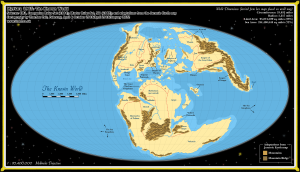The Atlas of the Outer Worlds: Charting the Frozen Frontiers of the Solar System

Introduction: Mapping the Frozen Frontier
When we imagine the solar system, the familiar planets — Mercury, Venus, Earth, and Mars — often take center stage. But far beyond the warmth of the Sun lies a region of astonishing beauty and mystery: the outer worlds. This vast, frozen frontier is home to gas giants, icy moons, dwarf planets, and a cloud of objects stretching toward interstellar space. These distant realms form the focus of “The Atlas of the Outer Worlds: Charting the Frozen Frontiers of the Solar System.”
For centuries, these worlds were little more than moving points of light in the night sky. Now, thanks to missions like Voyager and New Horizons, we are beginning to piece together detailed maps of these faraway places. The process of charting the outer solar system is a blend of science, art, and persistence — an ongoing journey into the cold unknown.
The Origins of the Outer Solar System
The solar system’s outer reaches tell the story of its origins. Billions of years ago, when the Sun formed from a collapsing cloud of gas and dust, much of the leftover material drifted outward. In these distant regions, sunlight was weak, and ices could remain solid. Here, the gas giants — Jupiter, Saturn, Uranus, and Neptune — gathered their mass, and beyond them, icy remnants formed the Kuiper Belt and Oort Cloud.
Mapping this region means uncovering how gravity, temperature, and time shaped it. By studying the outer worlds, astronomers can reconstruct how the solar system evolved and how planets formed under different conditions. Each map is a fossil record of cosmic history — a frozen diary of the Sun’s ancient nursery.
As NASA’s Solar System Exploration program notes, “Every new map extends our understanding of how the solar system fits together — like a cosmic jigsaw puzzle that grows with every piece we find.”
Tools of Discovery: How We Map the Unknown
Mapping the outer solar system requires ingenuity and technology designed to survive extreme distances and cold. Unlike the inner planets, which can be visited repeatedly by orbiters and landers, the outer worlds are so far away that missions often take decades to reach them.
Key tools and methods include:
- Space Probes: Voyagers 1 and 2, launched in 1977, provided humanity’s first close-up views of Jupiter, Saturn, Uranus, and Neptune. Their maps remain foundational today.
- Flyby Missions: The New Horizons mission gave us breathtaking images of Pluto and Arrokoth, transforming our understanding of distant dwarf planets.
- Telescopic Surveys: Powerful telescopes like the James Webb Space Telescope (JWST) and the Hubble Space Telescope provide high-resolution data on distant icy bodies.
- Computer Simulations: Advanced models help astronomers predict orbital paths, collisions, and the formation of rings, moons, and belts.
These tools are expanding “The Atlas of the Outer Worlds,” a digital map that continues to evolve with every new observation. It’s a collaborative effort between agencies like NASA, ESA, and JAXA, and countless scientists who turn distant pixels into planetary landscapes.
The Giant Realms: Jupiter, Saturn, Uranus, and Neptune
Any atlas of the outer solar system must begin with the gas and ice giants — the massive planets that dominate the region beyond the asteroid belt.
Jupiter, the largest planet, is a world of storms and extremes. Its atmosphere, mapped in fine detail by the Juno mission, reveals swirling bands of ammonia clouds and the colossal Great Red Spot, a storm that has raged for centuries. Jupiter’s magnetic field extends millions of miles into space, shaping the solar wind and protecting the inner planets from cosmic debris.
Saturn, with its majestic rings, has captivated observers for centuries. The Cassini-Huygens mission mapped its rings and moons for over a decade, discovering complex structures and hidden moons embedded within the rings themselves. The maps of Titan, Saturn’s largest moon, revealed methane lakes and dunes that mirror Earth’s deserts.
Uranus and Neptune — the ice giants — remain less explored, yet equally fascinating. Voyager 2’s flybys in the 1980s offered our only close-up glimpses, showing hazy atmospheres, faint rings, and mysterious dark storms. Scientists hope future missions will create detailed maps of these planets, unlocking secrets about their composition and magnetic fields.
Icy Moons: Hidden Oceans and Alien Landscapes
Surrounding the gas giants are dozens of moons — miniature worlds with their own stories. Some of these moons have become prime targets for exploration due to their potential habitability.
Europa, one of Jupiter’s moons, is covered in ice but believed to hide a vast ocean beneath its crust. Mapping its surface cracks and ridges helps scientists locate places where water might emerge, providing clues to life’s possibilities beyond Earth. NASA’s upcoming Europa Clipper mission will build a high-resolution atlas of this moon’s frozen surface.
Enceladus, a small moon of Saturn, astonished researchers when the Cassini spacecraft captured images of water jets erupting from its south pole. These geysers suggest a subsurface ocean rich in organic molecules — a world that may harbor microbial life.
Titan, Saturn’s largest moon, has rivers and lakes of liquid methane and ethane. Radar mapping has shown continents, dunes, and weather patterns that resemble Earth’s hydrological cycle — but with different chemistry. Titan’s maps are like studying an alien version of Earth frozen in twilight.
The Kuiper Belt: Gateway to the Deep Freeze
Beyond Neptune lies the Kuiper Belt, a vast region of icy bodies and remnants from the early solar system. This belt is the frozen frontier — a cosmic archive of primordial materials untouched for billions of years.
The New Horizons spacecraft transformed our view of the Kuiper Belt. After passing Pluto, it visited Arrokoth (2014 MU69), revealing a contact binary — two icy bodies fused together — that preserved the original conditions of planetary formation.
Mapping the Kuiper Belt involves identifying and tracking thousands of objects, some no larger than mountains, others approaching planetary size. Their orbits form patterns that may hint at unseen gravitational influences, possibly even a hidden planet lurking in the darkness.
As astronomers continue to refine “The Atlas of the Outer Worlds,” the Kuiper Belt remains one of its most dynamic and challenging chapters — a realm where every discovery rewrites what we thought we knew about the solar system’s edge.
Pluto and Beyond: The Dwarfs of the Deep
Once considered the ninth planet, Pluto now stands as the most famous of the dwarf planets. When New Horizons flew past in 2015, it revealed an astonishingly complex world — one that defied all expectations. From nitrogen glaciers to towering ice mountains and a hazy, blue atmosphere, Pluto’s maps revealed a living world of geological surprises.
Other dwarf planets like Haumea, Makemake, and Eris occupy the same frozen domain. Each presents unique mysteries: Haumea spins so rapidly it’s elongated like an egg; Makemake shows methane ice on its surface; Eris, even farther than Pluto, may be more massive and denser. Mapping these bodies helps define what it means to be a planet and where the boundaries of our system truly lie.
Collectively, they form the “frozen family” of the outer solar system — worlds that bridge the gap between planets and comets, their orbits tracing the unseen architecture of the Sun’s gravitational reach.
The Search for Planet Nine
Perhaps the most tantalizing mystery of all lies beyond Pluto — the potential existence of Planet Nine. Observations of distant Kuiper Belt objects show unusual orbital alignments, as if tugged by a massive, unseen planet. Theoretical models suggest it could be ten times the mass of Earth, orbiting hundreds of times farther from the Sun.
Despite years of searching with the European Southern Observatory’s Very Large Telescope and other observatories, Planet Nine remains elusive. Mapping its possible orbit is a detective story that combines mathematics, physics, and patience. If found, it would expand “The Atlas of the Outer Worlds” dramatically — adding a new chapter to humanity’s understanding of our solar family.
Technology and the Future of Outer Solar System Mapping
The next era of exploration will rely on new technologies designed for endurance and autonomy. Solar power fades quickly at these distances, so nuclear-powered spacecraft like Voyager and New Horizons serve as models for future missions.
Advanced AI navigation systems may soon allow probes to make decisions without human input, adapting to unforeseen terrain or opportunities. Swarms of nanosatellites could work together to map wide regions simultaneously, while deep-space drones explore surfaces and plumes in real time.
Collaborative international missions are also on the rise. ESA’s JUICE (Jupiter Icy Moons Explorer) and NASA’s Europa Clipper are both focused on mapping potentially habitable worlds. Meanwhile, proposals for a future “Ice Giants Mission” aim to orbit Uranus or Neptune — completing our solar atlas at last.
The Expanding Atlas of the Outer Worlds
“The Atlas of the Outer Worlds: Charting the Frozen Frontiers of the Solar System” is more than a scientific endeavor — it’s a testament to human curiosity. Each new map, each blurry pixel turned into a landscape, represents centuries of persistence and imagination.
From Jupiter’s swirling storms to Pluto’s icy plains, we’ve charted the unimaginable. Yet, as we reach farther into the dark, we realize how much remains uncharted. The outer solar system is not a static frontier; it’s a living, evolving realm where new mysteries arise with every discovery.
Someday, future explorers — robotic or human — will walk these distant worlds, turning maps into memories. Until then, our cosmic atlas continues to grow, page by page, through the lens of science and the spirit of exploration.
Si quieres conocer otros artículos parecidos a The Atlas of the Outer Worlds: Charting the Frozen Frontiers of the Solar System puedes visitar la categoría Solar System.

